Developing an Urban Visualization System for Virtual Environments using
Computer Graphics
(TUBITAK CAREER Award)
We developed an urban visualization framework for the population and visualization of complex urban environments (see Figure 1). To this end, we develop a novel data structure for the storage and representation of buildings in an urban environment, called slicewise representation, which reduces the computational and storage costs of the modeling, visualization and rendering of urban environments; an occlusion culling algorithm, which speeds up the visualization of city models during walkthrough in these environments. The slice-wise representation is based on the observation that the visible parts of the buildings in a typical urban walkthrough are mostly in one of the following three cases (see Figures 2 and 3). Our occlusion culling algorithm is a conservative algorithm based on occluder shrinking. Figure 4 illustrates the shrinking method we used applied on a three dimensional object.
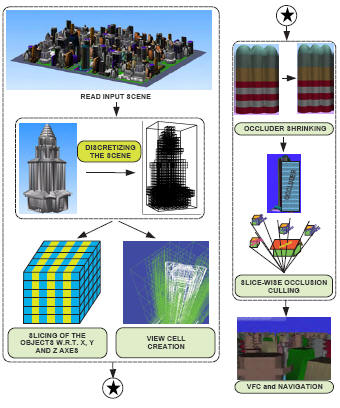
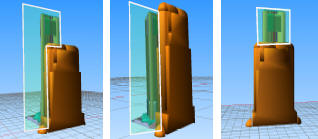
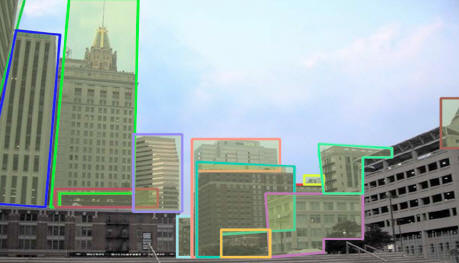
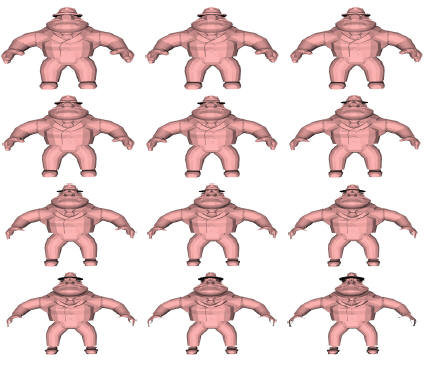
We propose techniques for the monoscopic and stereoscopic visualization of urban environments. To speed up the stereoscopic visualization, we propose to generate the view for one eye using the view for the other, instead of generating the two views separately. We also exploited the Graphics Processor Unit and the related data structures, such as Vertex Buffer Objects, to speed up the visualization process (see Figure 5).
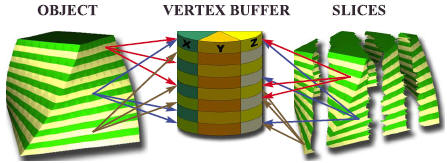
We model the crowds in urban environments using a model-based approach where each agent
can show complex behaviors based on its skeletal motion. We use occlusion culling to
eliminate the agents that are occluded by the buildings and view frustum culling to eliminate
agents that are out of the view frustum for fast rendering of crowds. We also use different
levels of details of the agents to render the agents according to the distance from the
viewpoint. We also work on approaches for global and local path planning for the behavior of
agents in crowds. We model the spreading of the panic behavior throughout the crowd. We
propose techniques to simulate the behavior of agents for normal and emergency situations,
such as fire, explosion, and terrorist attacks, in outdoor environments (see Figure 6).
We also study the effects of personality traits to the crowd behavior for indoor environments, such as museums, exhibition galleries.

We also study the effects of personality traits to the crowd behavior for indoor environments, such as museums, exhibition galleries (see Figures 7 and 8).
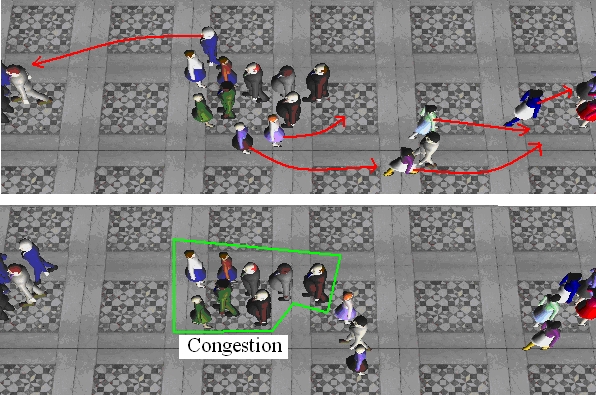
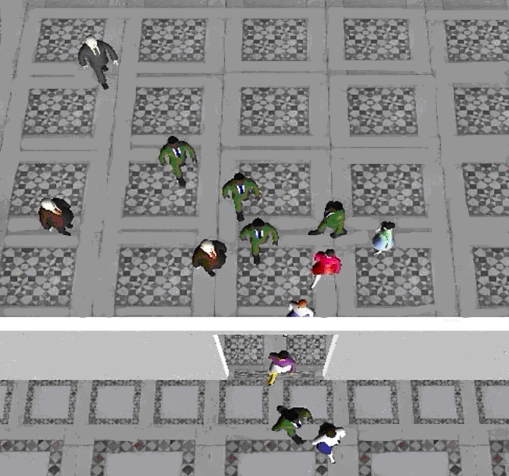
The developed techniques and the proposed framework can be used in urban planning, military simulations, geographical information systems, tourism, entertainment industry, including the film sector and computer games, and security applications.
Project Publications
Journal Articles
- Funda Durupınar, Nuria Pelechano, Jan Allbeck, Uğur Güdükbay, Norman Badler, "How the Ocean Personality Model Affects the Perception of Crowds", IEEE Computer Graphics and Applications, Vol. 31, No. 3, pp. 22-31, May/June 2011. (pdf).
- Oğuzcan Oğuz, Ateş Akaydın, Türker Yılmaz, Uğur Güdükbay, "Emergency Crowd Simulation for Outdoor Environments", Computers & Graphics, Vol. 34, No. 2, pp. 136-144, April 2010. (pdf), (Video).
- Funda Durupınar, Uğur Güdükbay, "Visualization of crowd synchronization on footbridges", Journal of Visualization, Vol. 13., No. 1, pp. 69-77, February 2010. (pdf), (Video).
- Evren İmre, A. Aydın Alatan, Uğur Güdükbay, "Rate-Distortion Efficient Piecewise Planar 3-D Scene Representation From 2-D Images", IEEE Transactions on Image Processing, Vol. 18, No. 3, pp. 483-494, March 2009. (pdf).
- Türker Yılmaz, Uğur Güdükbay, "Stereoscopic Urban Visualization Based on Graphics Processor Unit", Optical Engineering, Vol. 47, No. 9, Article No. 097005, 10 pages, September 2008. (pdf).
- Türker Yılmaz and Uğur Güdükbay, "Conservative Occlusion Culling for Urban Visualization Using a Slice-wise Data Structure", Graphical Models, Vol. 69, Issues 3-4, pp. 191-210, May-July 2007. (pdf).
Conference Publications
- Oğuzcan Oğuz, Medeni Erol Aran, Türker Yılmaz, and Uğur Güdükbay, "Automatic Production and Visualization of Urban Models from Building Allocation Plans", in Technical Poster Proceedings of Brazilian Symposium on Computer Graphics and Image Processing, (SIBGRAPI'06), Manaus/Amazonas, Brazil. (pdf).
- Oğuzcan Oğuz, Medeni Erol Aran, Türker Yılmaz, and Uğur Güdükbay, "Bina Tahsis Planlarından 3-Boyutlu Şehir Modellerinin Üretilmesi ve Görüntülenmesi" (in Turkish), IEEE Sinyal İşleme ve Uygulamaları Kurultayı (SİU'06), Antalya, Turkey, April 2006. (pdf).
- Türker Yılmaz and Uğur Güdükbay, "Extraction of 3D Navigation Space in Virtual Urban Environments", in Proc. of 13th European Signal Processing Conference (EUSIPCO'05) (CD-ROM Proceedings), Special Session on Geometry Compression, September 2005. (pdf).
People:
- Faculty
- Uğur Güdükbay (Principal investigator)
- Researchers
- Türker Yılmaz (Ph.D. student)
- Funda Durupınar (Ph.D. student)
- Oğuzcan Oğuz (M.S. student)
- Ates Akaydın (M.S. student)
- Medeni Erol Aran (M.S. student)
Duration:
April 2005 - April 2010
Sponsor:
TUBITAK - Scientific and Technical Research Council of Turkey (Grant no: 104E029)Budget:
169,000 YTL (~US$110,000)